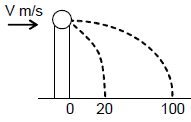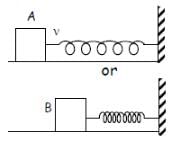JEE Advanced 2011 Paper - 2 with Solutions - JEE MCQ
30 Questions MCQ Test - JEE Advanced 2011 Paper - 2 with Solutions
SECTION – I (Total Marks : 24)
(Single Correct Answer Type)
This Section contains 8 multiple choice questions. Each question has four choices (A), (B), (C) and (D) out of
which ONLY ONE is correct.
Q. Which of the field patterns given below is valid for electric field as well as for magnetic field?
which ONLY ONE is correct.
A ball of mass 0.2 kg rests on a vertical post of height 5 m. A bullet of mass 0.01 kg, traveling with a velocity V m/s in a horizontal direction, hits the centre of the ball. After the collision, the ball and bullet travel independently. The ball hits the ground at a distance of 20 m and the bullet at a distance of 100 m from the foot of the post. The velocity V of the bullet is

The density of a solid ball is to be determined in an experiment. The diameter of the ball is measured with
a screw gauge, whose pitch is 0.5 mm and there are 50 divisions on the circular scale. The reading on the
main scale is 2.5 mm and that on the circular scale is 20 divisions. If the measured mass of the ball has a
relative error of 2 %, the relative percentage error in the density is
a screw gauge, whose pitch is 0.5 mm and there are 50 divisions on the circular scale. The reading on the
main scale is 2.5 mm and that on the circular scale is 20 divisions. If the measured mass of the ball has a
relative error of 2 %, the relative percentage error in the density is
A wooden block performs SHM on a frictionless surface with frequency, ν0. The block carries a charge +Q on its surface. If now a uniform electric field is switched-on as shown, then the SHM of the block will be
A light ray travelling in glass medium is incident on glass-air interface at an angle of incidence θ. The reflected (R) and transmitted (T) intensities, both as function of θ, are plotted. The correct sketch is
A satellite is moving with a constant speed ‘V’ in a circular orbit about the earth. An object of mass ‘m’ is
ejected from the satellite such that it just escapes from the gravitational pull of the earth. At the time of its
ejection, the kinetic energy of the object is
A long insulated copper wire is closely wound as a spiral of ‘N’ turns. The spiral has inner radius ‘a’ and outer radius ‘b’. The spiral lies in the XY plane and a steady current ‘I’ flows through the wire. The Z-component of the magnetic field at the centre of the spiral is
A point mass is subjected to two simultaneous sinusoidal displacements in x-direction, x1(t) = A sinωt and
Adding a third sinusoidal displacement x3(t) = B sin (ωt + φ) brings the mass to a complete rest. The values of B and φ are
SECTION – II (Total Marks : 16)
(Multiple Correct Answer(s) Type)
This section contains 4 multiple choice questions. Each question has four choices (A), (B), (C) and (D) out of
which ONE OR MORE may be correct.
Q. Two solid spheres A and B of equal volumes but of different densities dA and dB are connected by a string. They are fully immersed in a fluid of density dF. They get arranged into an equilibrium state as shown in the figure with a tension in the string. The arrangement is possible only if
A thin ring of mass 2 kg and radius 0.5 m is rolling without on a horizontal plane with velocity 1 m/s. A small ball of mass 0.1 kg, moving with velocity 20 m/s in the opposite direction hits the ring at a height of 0.75 m and goes vertically up with velocity 10 m/s. Immediately after the collision
Which of the following statement(s) is/are correct?
A series R-C circuit is connected to AC voltage source. Consider two cases; (A) when C is without a dielectric medium and (B) when C is filled with dielectric of constant 4. The current IR through the resistor and voltage VC across the capacitor are compared in the two cases. Which of the following is/are true?
SECTION-III (Total Marks : 24)
(Integer Answer Type)
This section contains 6 questions. The answer to each of the questions is a single-digit integer, ranging from 0 to 9.
Enter only the numerical value in the space provided below.
Q. A series R-C combination is connected to an AC voltage of angular frequency ω = 500 radian/s. If the
impedance of the R-C circuit is the time constant (in millisecond) of the circuit is
A silver sphere of radius 1 cm and work function 4.7 eV is suspended from an insulating thread in freespace.
It is under continuous illumination of 200 nm wavelength light. As photoelectrons are emitted, the
sphere gets charged and acquires a potential. The maximum number of photoelectrons emitted from the
sphere is A x 10z (where 1 < A < 10). The value of ‘Z’ is
A train is moving along a straight line with a constant acceleration ‘a’. A boy standing in the train throws a
ball forward with a speed of 10 m/s, at an angle of 60° to the horizontal. The boy has to move forward by
1.15 m inside the train to catch the ball back at the initial height. The acceleration of the train, in m/s2, is
A block of mass 0.18 kg is attached to a spring of force-constant 2 N/m. The coefficient of friction between the block and the floor is 0.1. Initially the block is at rest and the spring is unstretched. An impulse is given to the block as shown in the figure. The block slides a distance of 0.06 m and comes to rest for the first time. The initial velocity of the block m/s is V = N/10. Then N is:
Two batteries of different emfs and different internal resistances are connected as shown. The voltage across AB in volts is
Water (with refractive index = 4/3 in a tank is 18 cm deep. Oil of refractive index 7/4 lies on water making a convex surface of radius of curvature ‘R = 6 cm’ as shown. Consider oil to act as a thin lens. An object ‘S’ is placed 24 cm above water surface. The location of its image is at ‘x’ cm above the bottom of the tank. Then ‘x’ is
(Matrix-Match Type)
This section contains 2 questions. Each question has four statements (A, B, C and D) given in Column I and five statements (p, q, r, s and t) in Column II. Any given statement in Column I can have correct matching with ONE or MORE statement(s) given in Column II.
Q. One mole of a monatomic gas is taken through a cycle ABCDA as shown in the P-V diagram. Column II give the characteristics involved in the cycle. Match them with each of the processes given in Column I.
Column I shows four systems, each of the same length L, for producing standing waves. The lowest
possible natural frequency of a system is called its fundamental frequency, whose wavelength is denoted as
λf. Match each system with statements given in Column II describing the nature and wavelength of the
standing waves.
SECTION – I (Total Marks : 24)
(Single Correct Answer Type)
This Section contains 8 multiple choice questions. Each question has four choices (A), (B), (C) and (D) out of
which ONLY ONE is correct.
Q. The freezing point (in oC) of a solution containing 0.1 g of K3[Fe(CN)6 (Mol. Wt. 329) in 100 g of water
(Kf = 1.86 K kg mol-1) is
Amongst the compounds given, the one that would form a brilliant colored dye on treatment with NaNO2 in
dil. HCl followed by addition to an alkaline solution of β-naphthol is
The major product of the following reaction is
Oxidation states of the metal in the minerals haematite and magnetite, respectively, are
Among the following complexes (K-P)
K3[Fe(CN)6] (K), [Co(NH3)6]Cl3 (L), Na3[Co(oxalate)3] (M), [Ni(H2O)6]Cl2 (N), K2[Pt(CN)4] (O) and
[Zn(H2O)6](NO3)2 (P)
Passing H2S gas into a mixture of Mn2+, Ni2+, Cu2+ and Hg2+ ions in an acidified aqueous solution precipitates
Consider the following cell reaction:
At [Fe2+] = 10-3 M, P(O2) = 0.1 atm and pH = 3, the cell potential at 25oC is
SECTION – II (Total Marks : 16)
(Multiple Correct Answer(s) Type)
This section contains 4 multiple choice questions. Each question has four choices (A), (B), (C) and (D) out of
which ONE OR MORE may be correct.
Q. Reduction of the metal centre in aqueous permanganate ion involves
The correct functional group X and the reagent/reaction conditions Y in the following scheme are





















